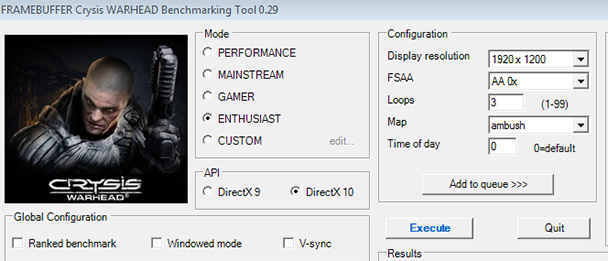HIS ATI Radeon HD 6990 Review. The Benchmarks.
A constructive comparison of the 6990’s performance should ideally feature its predecessor, the HD 5970, a pair of 6970’s to test in both single and crossfire configurations and Nvidia’s direct response to ATI’s latest creation, the dual GPU GTX 590. However, at the time of testing, the only other card at my disposal in the same performance bracket was a Zotac branded GTx 580, hence, this shall be our baseline reference.
We know that even AMD’s 5970 is able to edge out the GTX 580 in the majority of tests. Nevertheless, there remains a significant number of scenarios, including those mentioned at the beginning of this article, where either the tables are turned or the winning margin is very small. At the time of this analysis, the approximate price we can expect to pay for a GTX 580 is £390, while the 6990 will set us back around £100 more at £490, therefore, the 6990 will have to yield a 25% performance gain over its rival in order ensure a truly moral victory.
Crossfire vs SLI?
Scaling has consistently been something of a let down when it comes to dual GPU cards, the additional investment one makes to acquire a second card is rarely justified by the resulting performance gain. In our previous comparison, which pitted three GTX580s against two HD 5970s, we observed that the Nvidia cards were able to comfortably outscore their red rivals and moreover, that their advantage increased dramatically as soon as anisotropic filtering and anti-aliasing became part of the equation. While it’s true that the 580 emerged almost a year after the 5970 and would therefor have the benifit of extra time in development, the fact remains that the 5970, though still able set the standard when only a single card is used, does not scale nearly as well as the 580 when multiple cards are installed.
We have already discussed how the 5970’s “relative” memory limitations contribute to its lack of performance at high and eye-candy heavy resolutions but it is important to note that this does not entirely account for its poor scaling, nor has the issue been exclusive to ATI’s dual GPU cards. In fact every dual GPU card since Nvidia’s introductory 7900gx2 has, with the exception of a handful of games and benchmarks, scaled far worse in SLI and Crossfire than their single GPU counterparts:
NVidia:
9800gx2 (Dual GPU – 1024mb shared memory) vs. 8800gtx/8800gtx ultra/9800gtx/9800gtx+ (single GPU – 768mb/512mb dedicated memory).
The 9800gx2 yielded good results as a single card but was disappointing in SLI, even when compared to its one and a half year old predecessors.
Gtx 295 (dual GPU – 1792mb shared memory) vs. gtx 260/280/gtx 285 (single GPU – 896/1024mb dedicated memory).
One on one, the gtx 295 comprehensively outclassed the 260, 280 and 285, but soon as a second card was added – which one would expect to benefit the 295 even more – its advantage was significantly reduced. In TRI-SLI, the performance of three 280/285s displaced that of two 295s, despite each setup costing roughly the same.
ATI:
3870×2 (dual GPU – 1024mb shared memory) vs. 3870 (512mb dedicated memory)
4870×2 (dual GPU – 2048mb shared memory vs. 4870 (512/1024mb dedicated memory)
The last two generations of ATI’s flagship cards saw identical chips used on both the single and dual GPU models and unlike Nvidia, the same amount of memory allocated to each GPU. With one card, things panned out as expected. The performance of a single 3870×2/4870×2 was almost exactly double that of a 3870/4870. However, in both cases, adding a second card, yielded a pathetically small performance increase for the price. Despite constant promises of driver improvements for both quad SLI and quad crossfire. It would appear that, besides memory hindrances, the programming complications encountered when developing and refining drivers for 4 way GPU configurations also play their part in the underwhelming performance we have thus far witnessed from such setups.
To take the price vs performance debate to its logical extreme and establish whether or not the 6990s extra memory and ATI’s latest drivers have been able to break this long standing curse, I have decided to also include two further sets of results, one from a TRI SLI configuration made up of 3 GTX 580s and the other from a series of tests conducted on a dual 6990 setup. The cost of each package at the the time of writing is approximately £980 for a pair of ATI’s 6990, while three GTX 580s will burn a £1170 hole in the enthusiast’s pocket so this time, it is Nvidia that will need to justify £190 of additional investment by converting it to a performance gain of 20% or greater.
Each of the tests was run using three alternate settings for visual quality. When seeking to improve visual quality, two options are called upon above all others, Anti aliasing, to blend jagged edges and Anisotropic Filtering, to enhance the appearance of textures. Numerous additional options for fine tuning “eye candy” are offered by both ATI’s and Nvidia’s driver software, though since most are specific to one or the other, these were not employed during testing.
Where made permissible by the application, the following profiles were used:
Low Quality – 1920×1200 and 2560x1600 – 0xaa and 0xaf – This is the default profile with both anti-aliasing (aa) and anisotropic filtering (af) disabled and thus, the lowest quality.
Medium Quality – 1920×1200 and 2560x1600 – 4xaa and 16xaf – This profile has anti-aliasing set to 4x (4 samples) and anisotropic filtering set to 16x, the maximum currently possible.
High Quality- 1920x1200 and 2560x1600 – 8xaa and 16xaf – The third profile has anti-aliasing set to 8x while anisotropic filtering remains at 16x.
Settings for both AA and AF were initially applied within the application or benchmark, if either of these options was not available, they were selected in the driver software’s control panel. All other settings were left at their driver defaults.
If one or more of the above profiles was not enforceable in a particular benchmark, either via the video card’s control panel or within the software’s configuration options, the test was skipped and/or a “best match” alternative was run it its place.For each test, where possible, the minimum, average and maximum frame rates were recorded and have been included in the accompanying bar graphs for reference. The two most important figures are those for the minimum and average framerates since it is these that have the biggest impact on user interaction and ultimately determine a smooth, responsive and enjoyable gaming experience or one riddled with choppiness and frustration. The video below from a previous series of tests pitting three GTX 580s against two HD 5970s serves as convicing evidence of just how noticable this problem can become.
Unigine Dual HD 5970 vs. Triple GTX 580
Get the Flash Player to see this player.Test System Configuration.
Asus P6T7 Supercomputer.
– Intel Core I7 980X 3.33ghz (stock speed with Intel Turboboost enabled).
– 6GB Kingston HyperX 1866mhz (clocked at 1333mhz, latency 9-9-9-24).
– Silverstone Strider 1500w.
– 4x Samsing SSDs – Pb22-J 256GB.
(2x in RAID 0 array, 2x non-RAID. Game installed on RAID array).
– Auzentech X-Fi Home Theatre HD.
– Windows 7 x64.– Drivers, 270.61 Nvidia Forceware and ATI Catalyst 11.3 (official releases) All cards run at their default “stock” speeds.
Test 1. – Crysis Warhead.
Single card vs. Single card.

Whereas the HD 5970 struggled to sustain a smooth framerate at 1920×1200 with 8xAA and to an even greater degree at 2560×1600, the 6990 glided effortlessly through every iteration, maintaining an average in excess of the magic 30 FPS and thus, confirming the huge benefit yielded by its additional memory. In fact, for all three runs at the higher resolution,the minimum frame rate posted by AMD’s monster matched the maximum delivered by the 580.
Crossfire vs. SLI

A fascinating result here. The Nvidia cards as ever, scale brilliantly at both resolutions when in TRI SLI, whilst a second 6990 seems to offer only a modest bonus at 1920×1200. The question is, are we encountering a classic case of CPU bottle necking or is ATI’s scaling curse still rearing its ugly head? The answer is almost certainly the former and there is no clearer evidence than the results the 6990s managed to produce at the higher resolution of 2560×1600. These demonstrate a very healthy increase in performance overall and furthermore, one that is progressively larger as we enable AA and AF.
Crysis Warhead - Dual HD 6990 vs. Triple GTX 580
Get the Flash Player to see this player.Performance Analysis.

The percentages make things crystal clear, at 1920×1200, three 580s give us a raw performance boost of 81% relative to a single card and scale with an efficiency of 60%. These figures are based on the 3 results we obtained for average FPS at the resolution in question. The 6990s give us only an 8% raw performance gain at the same resolution and a scaling efficiency of just 54%. Both configurations are evidently being hampered by the CPU.
By contrast, at 2560×1600, we see a huge raw performance gain of 153% for the 580s with a scaling effeciency of 85% and for the ATI cards, a 59% increase in raw performance and a vastly improved scaling efficiency of 79%, not quite as high as with the Nvidia cards but remember, the 6990s are dual GPU cards and this is still massively impressive, especially when considering how the 5970s struggled in the same benchmark.
Finally, in the bang for the buck department, the 6990 more than makes good by its 25% advantage target for single card performance and in fact achieves a lead of 57% at 1920×1200 and an incredible 72% at 2560×1600 which, if we then subtract the 25% required to justify its higher price, gives it a net price/performance gain of 32% at 1920×1200 and 47% at 2560×1600.
For SLI/Crossfire, the 580s did perform 6% better at 1920×1200 though this is still 14% short of the 20% needed to justify their higher price and at 2560×1600, they fell 8% behind the 6990s, meaning that a pair of 6990s give superior performance for the price at both resolutions, by 14% and 28% respectively.
Test 2 – 3DMark 11.
Single vs. Single

The basic version of 3DMark 11 only allows for the “performance” profile to be used, this runs at a resolution of 1280×720 – lower than the equivelent profile in 3DMark Vantage – and claims to apply 1xmsaa (multi-sample anti aliasing) and 2x anisotropic filtering by default. However, since it is a much more graphically intensive series of tests, the scores show a difference more in line with those observed for “extreme” test in Vantage, with the 6990 again achieving a relative increase of over 50%.
Crossfire vs. SLI
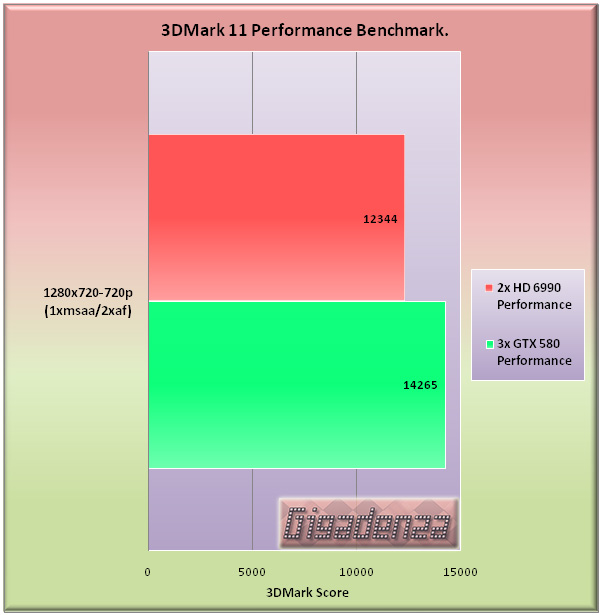
And the tables are turned, well, a little! Three 580s achieve a performance increase of almost 150% relative to a single card and scale with an efficiency of 82% per card whilst adding another 6990 gives us a bonus of 42% in raw performance and a scaling efficiency of 71% per card.
3DMark 11 - Dual HD 6990 vs. Triple GTX 580
Get the Flash Player to see this player.Performance Analysis.
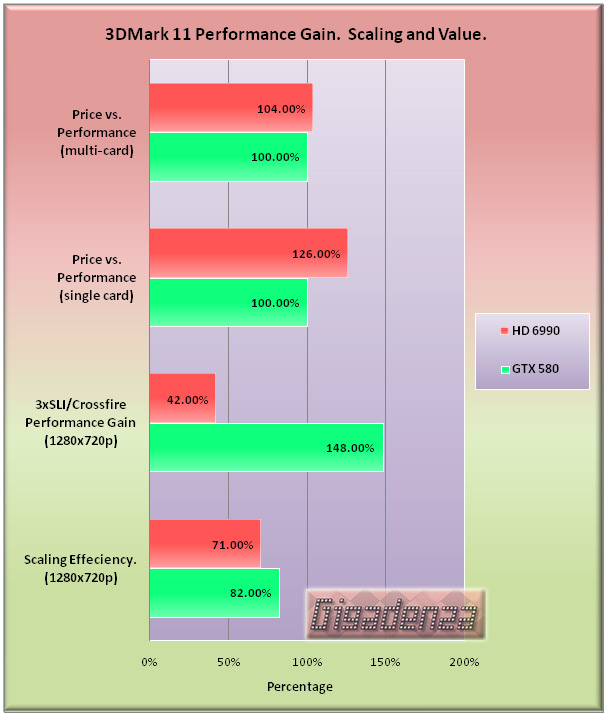
The 6990 again exceeds its 25% price justification target and commands an advantage of 51% in the single card battle and thus, representing 26% better value for money. In the multi-card face off, Nvidia wins on the scaling and performance fronts, though both results are impressive. However its advantage over the 6990s is only 16%, putting it 4% short of its 20% target and thereby handing the value award to ATI.
Test 3 – 3dMark Vantage.
Single vs. Single.

In the performance test, there is very little to choose between the cards, though once we move into extreme territory, the 6990 provides an increase of almost 50% relative to the 580’s score, an impressive result.
Crossfire vs. SLI
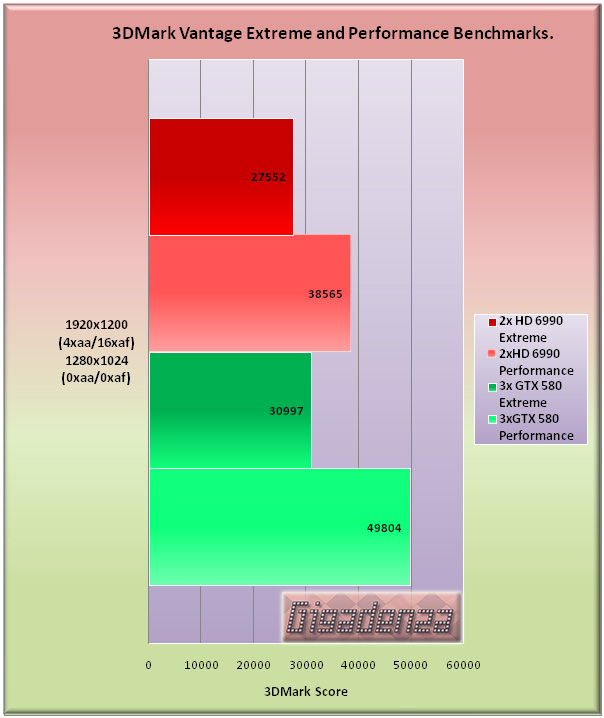
As expected, throwing two extra 580s into the equation results in a colossal improvement, enough to catch and overtake two 6990s in crossfire. This is a very impressive display of scaling efficiency from Nvidia but remember, these are only the raw figures and we’ve yet to see if they convert to a better solution for the price.
Performance Analysis.
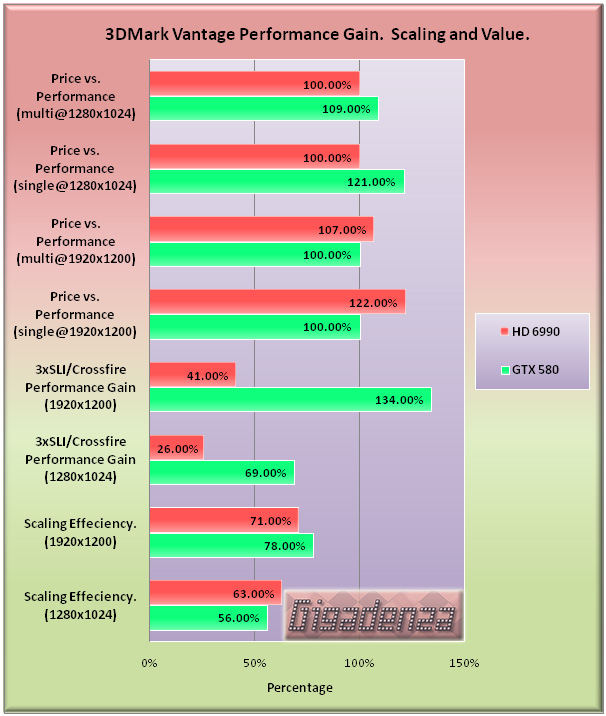
Well, technically its one a piece here. In the single card battle in Vantage’s “performance profile” – which automatically sets the resolution to 1280×1024 – the 6990 fails to reach its 25% target by some margin while on the multi-card front in the same test, the 580s exceed their 20% advantage. Therefor, the 580 represents better value in both single and multi-card (3x SLI) configurations in this particular test. It should be sressed however, that this test is all but redundant since there are very few who would choose to game at such a low resolution. Furthermore, looking at the comparatively inefficient scaling for both cards, it is likely that performance is once more being governed down by the CPU.
At the bussiness end in the “extreme profile” test, things look healthier for both setups. One on one, the 6990 surges ahead, while the 580s scale better and offer superior raw performance in 3x SLI than the 6990s do in Crossfire. But again, its the 6990 which siezes the “bang for buck” crown in each case.
Test 4 – Lost Planet 2
Single vs. Single

This benchmark only provides a figure for the average frame rate. Aside from being the closest result thus far, another interesting detail is that the performance penalty incurred when moving from 4Xaa to 8xaa, at both resolutions, its barely noticeable for either card, though at 2560×1600 the GTX 580 loses more ground relative to its rival, a discrepancy that can again be attributed to the 6990’s RAM advantage.
Crossfire vs. SLI
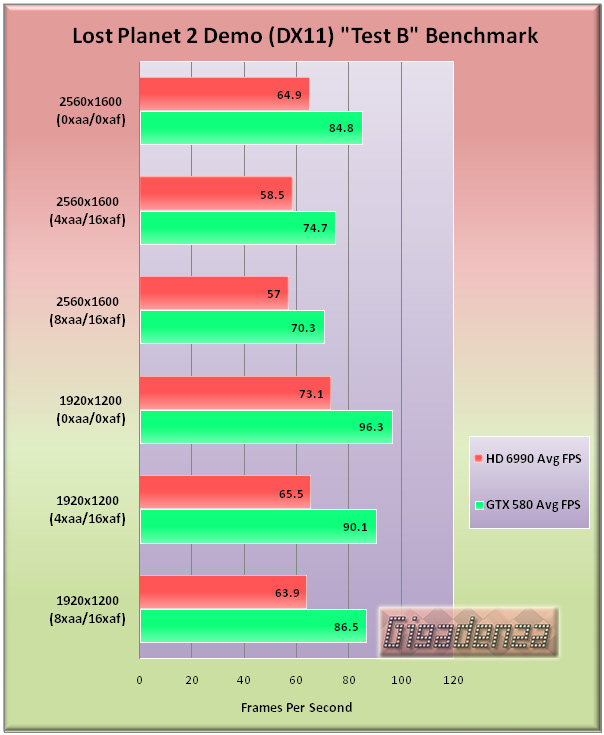
Moving into multi-card territory, two extra 580s is enough for Nvidia to pull ahead of ATI at 2560×1600 and extend its lead at 1920×1200.
Performance Analysis.
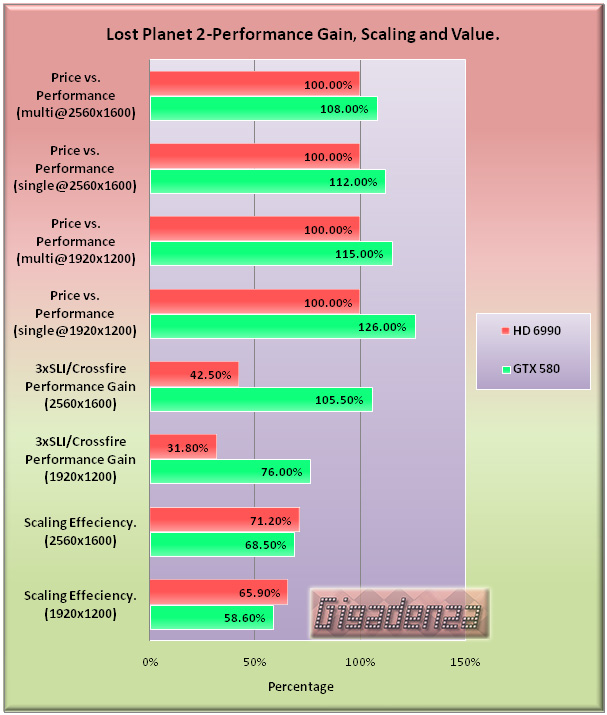
Despite less than stellar scaling by Nvidia’s standards, this is the first time the 580 has represented better value in both single and multi-card configurations. Overall, a single 6990 is actually a shade slower than one 580 at 1920×1200 and even though it gives a stronger showing at 2560×1600, the winning margin is only 13%, well short of its 25% target. The 580s in Tri SLI yield an advantage of 35% at 1920×1200 and 28% at 2560×1600 over ATI’s two red giants, surpassing their 20% target in each case and making this the first clean sweep for Nvidia in the price vs. performance battle.
Test 5 – Just Cause 2
Single vs. Single

A convincing victory for the 6990 at both resolutions with an ever widening gap as we enable aa and af.
Crossfire vs. SLI.

And so the pattern continues. Two additional 580s prove enough to haul in and pass cross-fired 6990s, though at 1920×1200, the CPU is once again a limiting factor. It should be noted that during each of the 6990’s runs, there was a sharp drop in frame rate towards the end which lasted between 5-10 seconds and will have had a significant impact on the results. The anomaly occurred at exactly the same point in each test and is almost certainly driver related.
Performance Analysis.
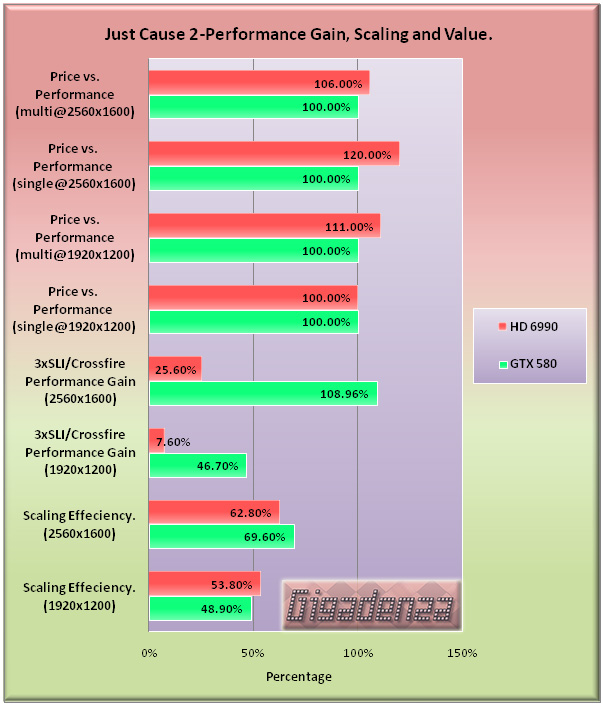
If anybody needed evidence that 1920×1200 is fast becoming a CPU bound resolution, this is about as convincing as it gets. Only a 47% gain for the 580s in TRI-SLI and a pathetic 8% for the 6990s in Quadfire. Comparing these figures to the improvements we see at 2560×1600 bears out the assertion even more, over double the gain for Nvidia at 109% and a far healthier 26% for ATI. The results for scaling follow a similar pattern with both cards working more efficiently at the higher resolution.
In the value stakes, at 1920×1200, ATI reached but did not surpass its 25% advantage for single card performance, meaning that both cards represent equal value at this resolution. At 2560×1600 however, its winning margin was an impressive 45%, which translates to 20% more performance for the price. Moving onto our multi card comparison, despite the 580s achieving higher scores at both resolutions, they still fell short of the 20% cushion required to justify the higher cost.
Test 6 – Battleforge 2.
Single vs. Single
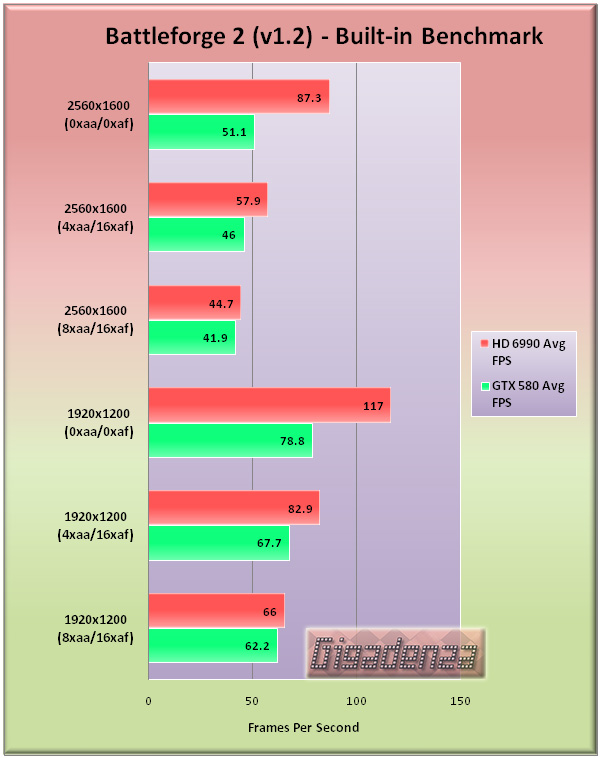
As the results confirm, the 6990 does indeed maintain a lead across the board at both resolutions though it must be said its advantage dwindles significantly once we move to 4xaa/16af, then again, to almost nothing, at 8xaa/18af. Even the most ardent of ATI fans would have to admit that in this case, the 580s efficiency when applying eye candy is nothing short of astounding.
Crossfire vs. SLI.
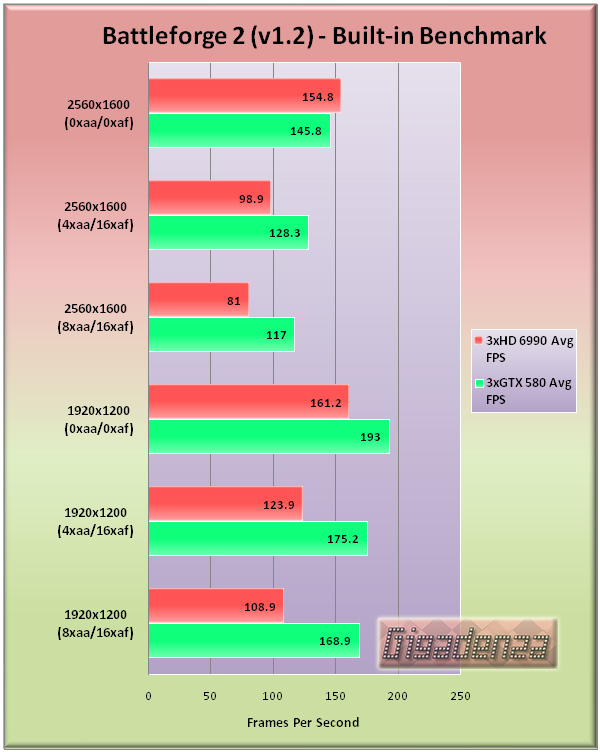
The same pattern yet again, three 580s out-muscle dual 6990s in all but one of the six tests and once more, the latter’s strongest results come without any eye candy applied, thereafter, the gap becomes ever wider the more we increase it. To ATI’s credit, the difference is a little smaller at 2560×1600 and frame rates were silky smooth at all times with no evidence of micro-stutter, a feat the memory starved 5970 would no doubt struggle to match.
Performance Analysis.
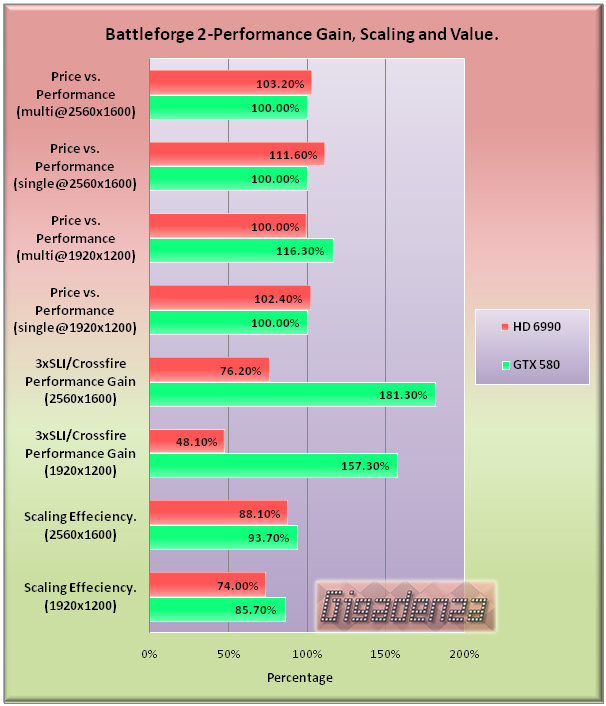
If the CPU has been a hindrance throughout some of our previous tests, there is very little evidence of it spoiling this party! Both cards demonstrate their most efficient scaling so far, a testament to how GPU intensive Battle Forge 2 remains.
Focusing on the results for 2560×1600, the performance gain of 181% achieved by the trio of 580s puts them just 19% shy of “perfect scaling” (which would be a 200% performance increase, 100% for each additional card). The 6990s in crossfire aren’t to be sniffed at either, at the higher resolution a second card affords the user a 76% performance bonus (only 24% short of perfect scaling) and at 1920×1200 a slightly less impressive though still highly respectable 48%.
Moving onto value for money, one on one, it’s the 6990 which once again burns your cash with a broader smile. At the lower and higher resolutions, its overall performance advantages were 27.4% and 36.6 which, if we then subtract 25% (the minimum winning margin required to justify the price) converts to 2.4% and 11.6% better value in each case.
In the multi-card comparison, three 580s overhauled two 6990s by 36.3% at 1920×1200 but only 16.8% at 2560×1600, since the winning margin they needed was 20%, this means they represent significantly better value at the lower resolution but slightly worse at the higher.
Test 7 – Unigine Heaven.
As many shall no doubt recall, when tessellation became a much vaunted highlight of directX 11, it was comprehensively mastered by Nvidia. Even the GTX 480, despite falling under heavy criticism for lack of power efficiency, excessive heat, and underwhelming performance elsewhere, was able to roundly humble ATI’s 58XX series whenever this particular graphical technique was called upon. Since the Unigine benchmark is widely accepted as the most tessellation-intensive of all, these results will demonstrate whether or not the combination of new hardware and drivers is able to prove ATI’s assertion of a substantial gain in tessellation performance.
Single vs. Single
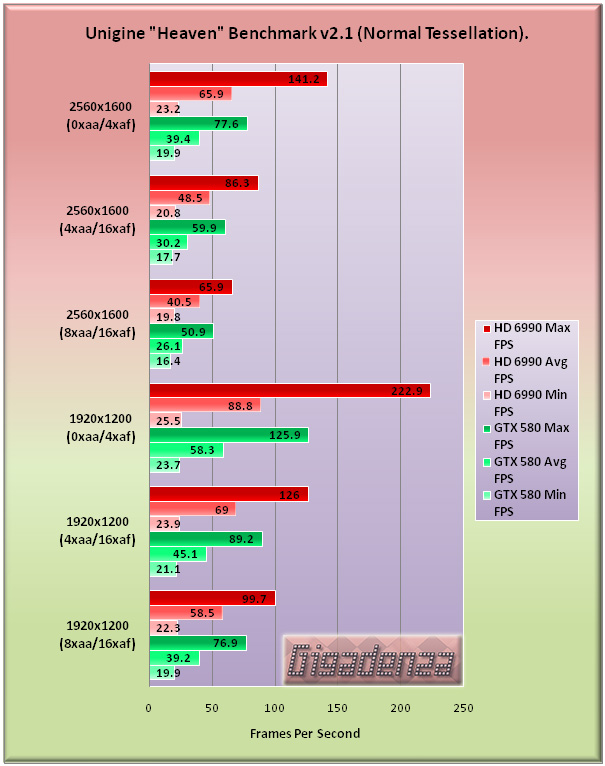
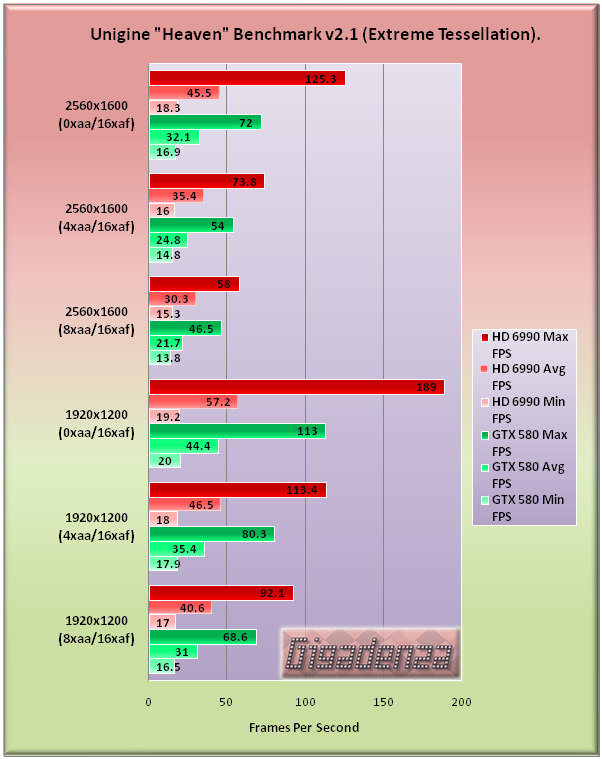
Looking at the first of the two charts above, with “normal tessellation” engaged, we can see that both cards acquit themselves impressively regardless of resolution and quality. The 580s result of 26.1fps at 2560×1600 with 8xaa and 16xaf is only occasion either dips below an average of 30fps.
Enabling Extreme tessellation takes its toll a little more on the 6990 and serves as strong evidence that Nvidia’s reign as tessellation champ remains intact. Nevertheless, it is ATI’s card that scores another decisive win in singles competition, posting higher, average and maximum frame rates in all twelve runs of the benchmark and a higher minimum frame rate in eleven out of twelve cases.
Crossfire vs. SLI
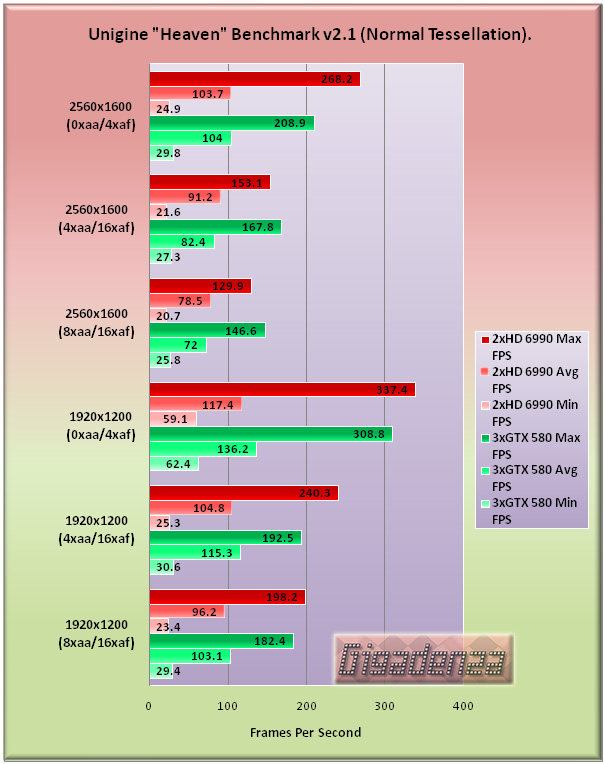
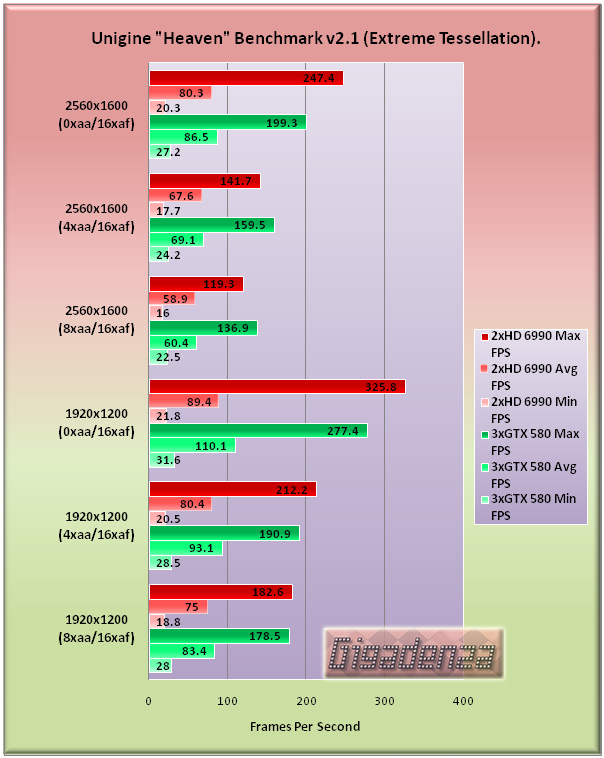
In the multi card face-off, things get very interesting. Focusing on the average frame rate, with Normal Tessellation active, three 580s out gun two 6990s at 1920×1200 but their lead is reduced as aa and af are applied. The ATi cards achieve a higher maximum frame rate for all three tests at this resolution but Nvidia turns the tables when it comes to minimum frame rates.
At the higher resolution, results for the average frame rates show that the 6990s manage to pull ahead once aa and af are present but the 580s again yield better minimum frame rates in all three runs and somewhat surprisingly, a higher maximum in two out of three.
With “extreme tessellation” active, the pattern is repeated, Nvidia leads but with a steadily decreasing gap as we increase quality and resolution, although this time, the 580s minimum and average frame rates are higher for all six tests.
Poor minimum frame rates have been a major issue for dual GPU cards in the past, especially when in SLI and crossfire, and indeed the 6990s exhibited small amount of micro-stutter at the start of the higher quality runs which was less or not at all manifest with the 580s, though it was still by far the smoothest performance by dual card/4-way GPU setup I have witnessed in this test.
The 6990’s improvement over its predecessor, the 5970, which floundered so badly amidst tessellation, does more than confirm that ATI’s has admirably refined their technology in this regard.
Those wanting first hand evidence are welcome to consult the video below, which shows simultaneous runs of the benchmark from two 5970s and two 6990s in crossfire, at 1920×1200, with extreme tessellation and aa+af applied.
Unigine - Dual HD 5970 vs. Dual HD 6990
Get the Flash Player to see this player.Performance Analysis.
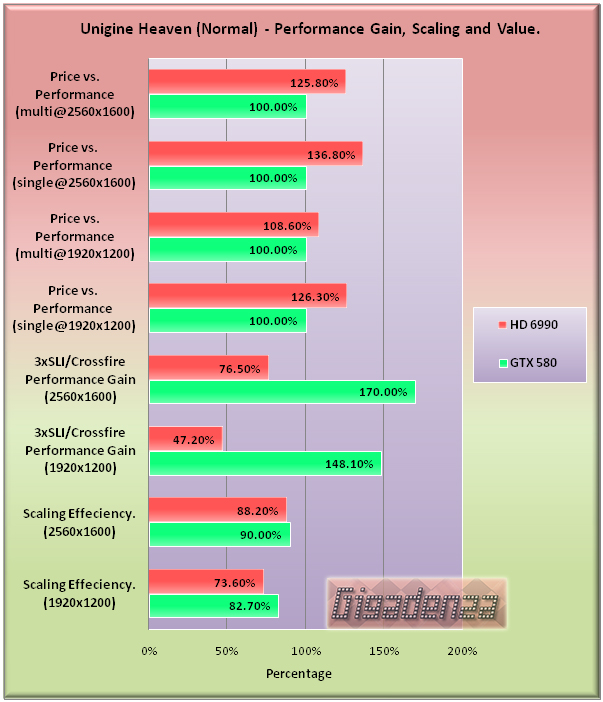
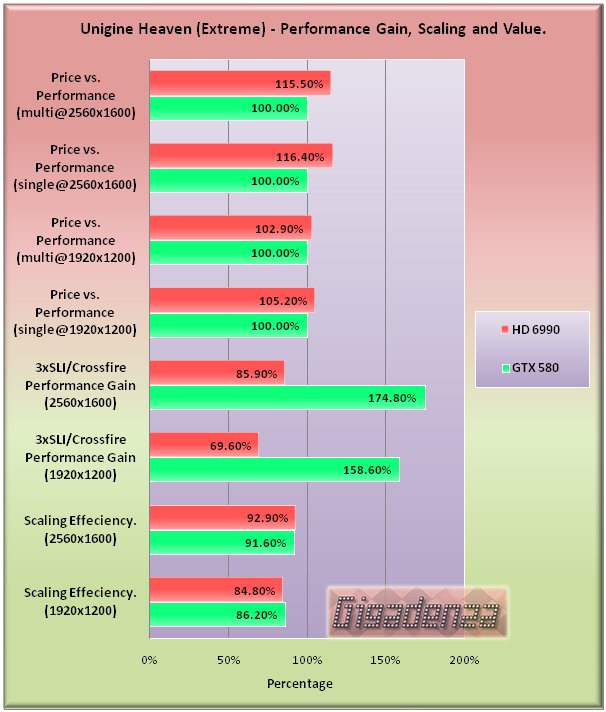
Glancing at the scaling results, we can promptly assert that even with normal tessellation, the Unigine benchmark provides more than enough obstacles for the cards to ensure they are not forming a disorderly queue behind the CPU!
The only slightly disappointing figure is the 47% increase yielded by the two 6990s at 1920×1200, though this still translates to a respectable scaling efficiency of 73.6%. The performance gain and scaling offered by our trio of 580s at the same resolution is more impressive, an increase of 148%, with each card flexing 82% of its muscles! At the higher resolution, ATI closes the gap. A healthy performance increase of 76% with a scaling efficiency of 88%, amongst the highest thus far for the red cards. Nvidia ups its game too, a gain of 170% in raw speed with each card just 10% shy of maximum efficiency.
Moving onto the extreme test, we witness a veritable scaling master class. At 1920×1200, adding a second 6990 provides a 69.6% performance gain while two additional 580s bring a further 158.6% of speed the party. These increases convert to equally impressive scaling with ATI now trailing Nvidia by a less than 2%. As if this weren’t enough, when switching to the higher resolution, the 580s raise the bar once more. A speed boost of 174.8% and scaling efficiency in excess of 90%. However, the 6990s turn in their best results of the entire review, an 85.9% performance bonus from a second card with both cards firing on 92.9% of their cylinders. This puts the red duo a shade ahead of Nvidia’s trio which, when considering the background of the Unigine benchmark and the 580s colossal scaling and tessellation powers, is an extremely significant victory.
When it comes to the question of value, it is ATI that achieves a clean sweep. The 6990’s advantage as a single card was substantial enough in both the normal and extreme tests to surge past the 25% target whilst the three 580s, despite winning the majority of tests in the multi-card battle, did not attain an overall lead greater than the magic 20%.
Conclusion.
In wrapping up this analysis it is important to reiterate its three objectives.
1. To establish which solutions provide the best raw performance irrespective of price
3. To compare the difference in raw performance of the solutions offered by both companies and use this data to find out which represents the best value.
3. To analyze the performance increase when running multiple video cards and assess whether the additional investment is worthwhile.
Raw Performance.
In singles competition, it’s no surprise that the 6990 emerges victorious since even the deposed 5970 was able to take the fight to a GTX 580 and score wins in numerous tests. Nevertheless, the subtle improvements ATI has made within its newly designed “Cayman” GPU combined with the notable addition of 2gb of video memory has ensured a far more decisive victory than many might have anticipated.
In the seven benchmarks we ran, there were 39 individual tests. For all but 3dMark, which provides its own score, victory was handed to the cards which achieved the highest average frame rate. In this case, the only time Nvidia got a look-in was during the Lost Planet 2 benchmark where the 580 briefly nosed ahead in two of the low resolution tests. For the remaining 6 benchmarks, which included 33 individual tests, ATI’s card dominated the proceedings.
Moving on to our multi-card comparison, we suspected things would be closer and were proven correct. Three 580s have already showcased their formidable powers against cross fired 5970s. But the big question posed at the start of this analysis was, would Ati’s drivers in harmony with the 6990s design enhancements and extra reserves of memory, allow it to apply itself more effectively in crossfire? In short…yes. The results for the Unigine benchmark alone are enough to confirm this.
Moreover, in Crysis Warhead, where two 5970s choked so badly amidst heavy eye-candy, a single 6990 is comfortably able to sustain fast and smooth frame rates . But how close would ATI get to Nvidia? Well, let’s look at the numbers. In the 39 tests we conducted, three 580s proved to be the winning formula for 33, while two 6990s managed just 6 victories. Nvidia therefore takes the performance crown though it should be noted, the 6990’s vastly improved performance and surprisingly efficient scaling made this battle hard fought.
Best value.
For our price vs. performance war, there were 15 separate results obtained from the seven benchmarks we ran and in 11 cases, the 6990’s winning margin in our singles face-off was greater than 25%, thereby justifying its higher price tag. Nvidia turned the tables on three occasions while one result provided us with a dead heat. To sum up, if you have the cash, the big red card is worth it!
Turning our attention to Crossfire and SLI. The 580s winning margin exceeded their target of 20% on just 4 occasions, for the remaining 11 tests, the 6990s were able to stay within range. Thus, Ati’s solution again represents better value, despite losing out in the performance stakes.
Worth it?
As to the question of whether or not either of these particular multi-card setups is worth the customers hard earned cash. In the real world and to the smart investor, the answer has to be no.
Put simply, an ideal scenario for most gaming enthusiasts will feature a resolution of at least 1920×1080 and consistently smooth frame rates that retain an average of above 30 frames per second. As was demonstrated in these tests, just one 6990 is more than capable of this, indeed even a single 580 only began to struggle during the Unigine benchmark and this was at the higher resolution of 2560×1600.
It is however, also fair to say that should money be of no concern, the acquisition of an extra card or two will certainly provide a substantial performance boost as well as broaden the enthusiast’s grin. Though many have stated multiple monitors are now essential to reap any benefit at all from configurations such as these, thanks to significant driver improvements by both ATI and Nvidia along with ever more demanding games and benchmarks, It is not difficult by applying a little eye candy to force these cards to sweat before the CPU becomes a limiting factor, they’ll merely be doing so at far higher frame rates than would be needed by most.





